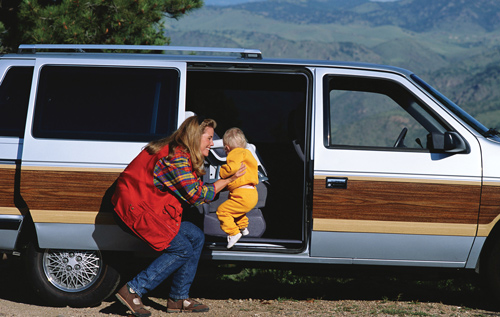
The Car Care Council

KIDS AND CAR SAFETY
By Royal Ford, Contributor, DriverSide.com
It was a horrific story that thankfully ended well. It reaches back to 1995 when Janette Fannell, her husband and infant son, returning home on an October night were kidnapped, the parents forced at gunpoint into the trunk of their car and the child abandoned in his car seat. Taken to a remote area, they were robbed and then locked in the trunk left to die.
For an hour, they tore at the trunk’s inner linings finally finding a way to open the trunk – something no child could have done. Their son was gone from the car, but after help arrived and took them home they found their son there, dropped off by the kidnappers. One kind act performed by depraved thieves.
You know those glow-in-the-dark interior pull latches that dangle inside your trunk and are so simple even a child can be taught to use them? Thank Janette Fannell for them, who after living through that terrible ordeal, fought federal bureaucracy to make them mandatory equipment in all automobiles.
But the story does not end there. Fannell is the founder and president of Kids and Cars, and the list of federally mandated legislation they have backed grows by the year. Right now, her battle is against a steady increase in hypothermia deaths of children left alone in cars on moderate to blazing hot days.
You’ve read the tabloid headlines: “Mom Boozes While Baby Girl Bakes in Car.” Wait a minute, says Fannell. In 1990-92, just before airbags became abundant, 11 children under 15 died of hypothermia in a car. Then airbags started killing kids strapped into the front seat and in 1996 airbag deaths of children reached a peak at 66. So we started strapping kids in the back seats (or in too many cases, not strapping them) and the numbers of children deaths due to hypothermia took off averaging 36 per year in the past decade.
So, it wasn’t boozing moms or out-with-the-boys fathers who were killing these children. In fact, a full 51 percent of these deaths resulted from frazzled forgetfulness by parent who did not remember they had a child in the back seat thanks to the new location of their car seats.
How can something like this happen? Usually, one parent or the other’s routine is interrupted; they don’t usually drive the baby to the sitter, the kid to school. The youngster falls asleep, is forgotten because they are not part of the daily drive, and are trapped in the car. Only 18 percent of these deaths occur among children left behind intentionally. Thirty percent are among children playing in unattended cars.
“This issue has everything to do with how our memories work,” Fannell says. Records kept by Kids and Cars show it has happened to a CEO, pediatrician, NASA scientist, firefighter, doctor and vice principal at a middle school. Fannell’s mission: educate parents with ideas such as placing a necessary item from your daily routine in the rear with the child: a briefcase, a pocketbook.
But also, and here she plows head on at the government and automakers, come up with a mandatory warning system that let’s you know if you have not, first, buckled your child, and second, you have not unbuckled them when you leave the car.
Consider the first: You’ve piled a stack of newspapers and magazines on the front passenger seat to drop off for recycling and put junior in the back but did not properly buckle him. A buzzer will go off if you don’t buckle your belt. A buzzer will go off warning you that that stack of newspapers and magazines needs to be buckled in. Junior? Not a sound.
And consider the second: After you park in the lot at work, or leave your keys in the ignition, or your car in drive, your headlights on, a door ajar, there’s a warning. Forget you have your child back there and haven’t unbuckled him? Again, silence. The answer: sensors to protect children. It isn’t rocket science even though NASA is among those working on such a solution. The challenge is to make them mandatory.
“We’ve been working on this forever,” sighs Fannell. “It just drives me crazy.” “Forever” in Fannell’s mind is a euphemism for “way too long.” That’s her ‘forever’ because she fights until she wins. Consider the Cameron Gulbransen Kids Transportation Safety Act signed by President Bush. It was named for a young boy whose doctor father went out one evening, climbed into the family car to run an errand, backed over what he thought was a tossed newspaper, and was horrified as he reached the end of the driveway to see a tiny shape wrapped in a blanket. His son had scooted from the house to ride with daddy.
The safety act will make it mandatory that automobiles come equipped with designs and equipment that give drivers far better vision of what lurks behind them. These could include the shapes of vehicles, pillar size, backup sensors, better mirrors and cameras.
Consider that recent models of the Honda Accord, Dodge Grand Caravan, Toyota Sequoia and Chevrolet Avalanche did not, in their worst cases, reveal in testing of rear view mirrors, child size cones placed, respectively, at 17, 24, 25 and 51 feet. There are whole driveways that aren’t 24 feet long.The bill also mandates pull-up switches to raise power windows replacing some versions that could be pressed down by a child’s elbow or finger and choke a child with their head sticking out an open window and a shift/brake system that will not let a car be shifted into gear if the brake is not depressed – something a small child could not do.
You can find much of this gear already on certain cars, some with auto reverse power windows. Sometimes it is an option, so please, buy that before you opt for the six CD changer or the power sunroof. The act also requires the federal government to start doing what Kids and Cars has had to do anecdotally and from news reports: set up a database of non-traffic incidents.
Fannell’s group, for instance, found that in 2007 and through Aug. 3 of 2011, nearly 1,200 children had been hurt in or by cars in non-traffic accidents and that 347 of them had died. These numbers, Fannell insists, are likely far below reality. Revealing that reality will make the fight more compelling. And it is a fight she vows to continue.
“Unless someone is fighting for the kids nothing gets done,” she says, forever dawning again tomorrow.

Car safety is more important than ever. Find out what is being done to make your car safer for you and your children at DriverSide.com.